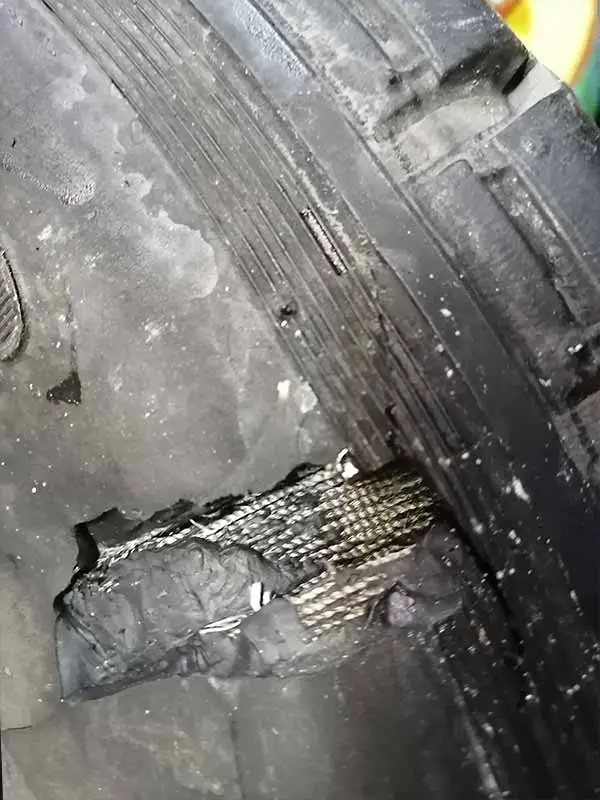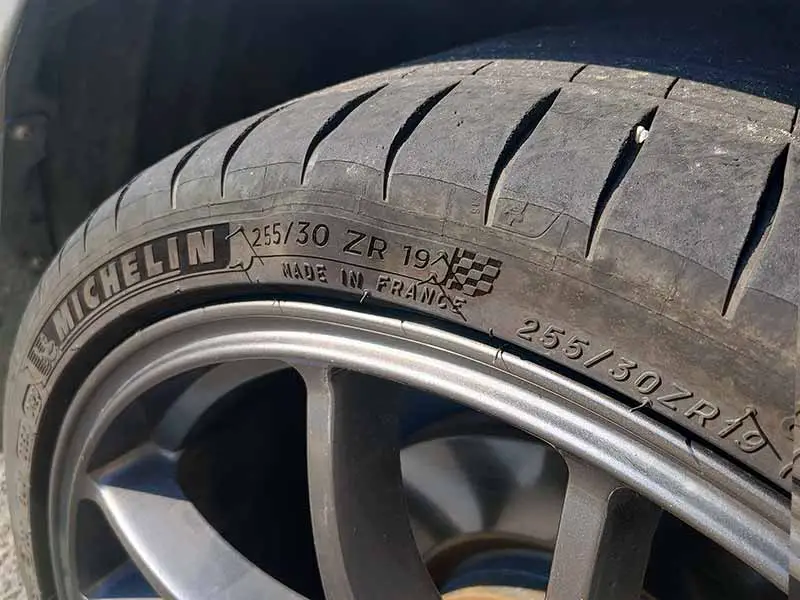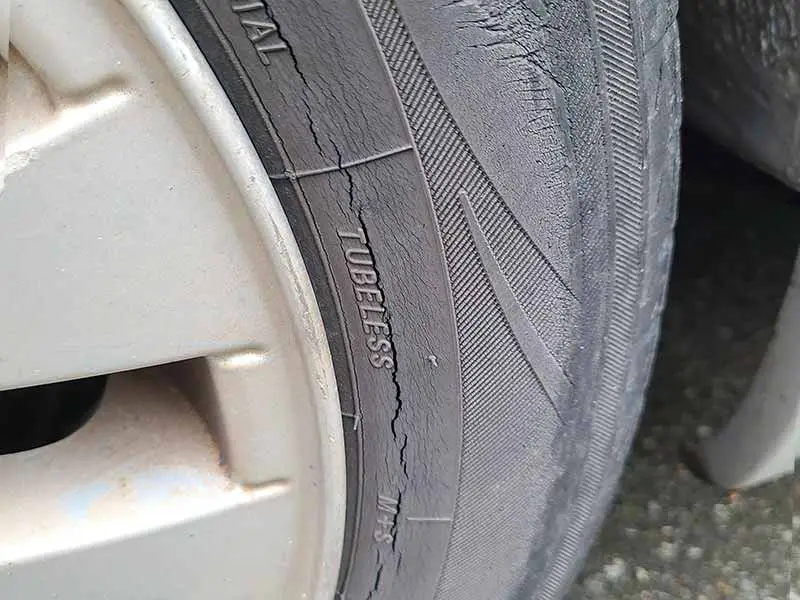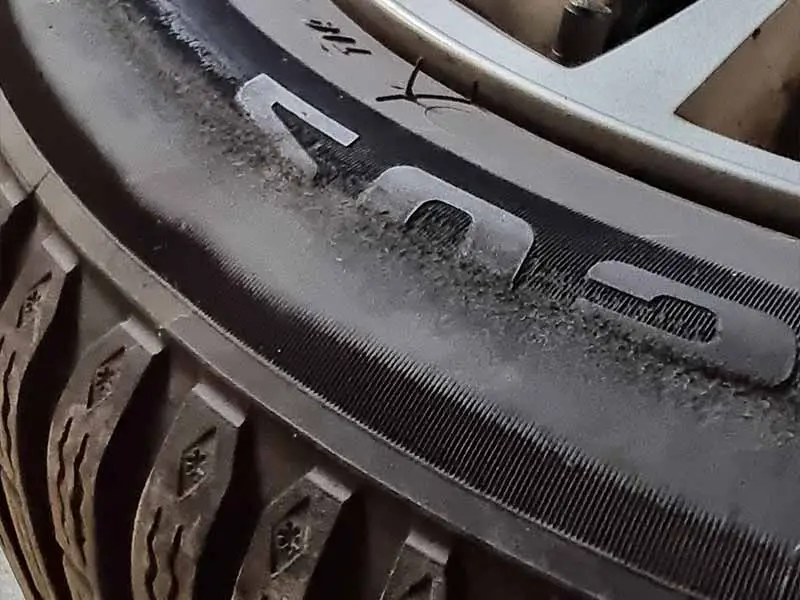Did you know that damaged tire sidewalls are responsible for numerous roadside breakdowns and accidents each year?
Your tire’s sidewall has the job of holding up the weight of your car or truck and experiences a lot of stress as the weight shifts in turns or over bumps.
Tire Sidewall Damage
Common types of tire sidewall damage include cuts, punctures, bulges, and cracking, which can be caused by road hazards, impact, improper inflation, or aging.
In this article, we will guide you through everything you need to know about tire sidewall damage, including its types, causes, and how to effectively handle repairs or replacements while prioritizing safety and tire longevity.
Let’s take a closer look.

Types Of Tire Sidewall Damage
Let’s cover some important information about different types of tire sidewall damage. The following are various issues you might encounter and how they can impact your tires:
Bulges And Blisters
Bulges and blisters are raised spots on the tire sidewall. They can appear when the tire’s inner lining gets damaged, allowing air to leak into the outer layers. This creates a weak spot in the tire and may lead to a sudden blowout. Keep an eye out for these bulges, as they’re a sign that your tire might need replacement.
Cuts And Punctures
Cuts and punctures are small holes or slits in the tire sidewall, typically caused by sharp objects like glass, nails, or rocks.
If you spot a cut or puncture in your tire sidewall, it’s crucial to have it checked by a professional as soon as possible. In most cases, a tire with sidewall damage like this cannot be repaired and must be replaced to ensure your safety on the road.
Cracking And Dry Rot
Over time, tires can develop cracks in their sidewalls due to factors like age, exposure to sunlight, and extreme temperatures. This is known as dry rot.
These cracks may appear as tiny lines or spiderweb patterns, and they can weaken your tire’s structure. If left unchecked, dry rot can cause your tire to lose air pressure, which might lead to a flat tire or even a blowout.
If you see signs of cracking or dry rot on your tires, it’s best to consult with a professional to determine if you need a replacement.
Scratches And Scuff Marks
Scratches and scuff marks on the tire sidewall are usually a result of minor impacts with curbs or other obstacles. These types of damage may not be as severe as the others we’ve discussed, but they still deserve attention.
In most cases, scratches and scuff marks don’t compromise the tire’s structural integrity, but they can be unsightly. If you’re concerned about the appearance of your tires, you can consult a professional to see if cosmetic repairs can be made.

Causes Of Tire Sidewall Damage
Understanding the causes of tire sidewall damage is essential for preventing issues and ensuring your safety on the road.
Here, we’ll review some common causes of sidewall damage to help you be more aware and protect your tires:
Impact With Road Hazards
One of the most common causes of tire sidewall damage is impact with road hazards like potholes, curbs, and debris. These obstacles can create cuts, punctures, or even bulges in your tire sidewalls.
To minimize the risk of damage, try to avoid hitting these hazards whenever possible. Be cautious when driving through construction zones or on poorly maintained roads, and give yourself plenty of space to maneuver around obstacles.
Underinflation Or Overinflation
Improper tire inflation can also lead to sidewall damage. Underinflated tires have a higher risk of bulging or blistering, as the sidewalls must flex more to support the vehicle’s weight.
Overinflated tires are more susceptible to punctures and cuts, as they become more rigid and less able to absorb impacts. To avoid these issues, check your tire pressure regularly and follow the manufacturer’s recommendations for proper inflation.
Age And Environmental Factors
As tires age, they become more vulnerable to damage. Over time, the rubber in the tire can break down, making it more susceptible to cracking, dry rot, and other issues. Environmental factors like sunlight, extreme temperatures, and exposure to chemicals can also accelerate tire aging and cause damage.
To protect your tires, store your vehicle in a shaded, temperature-controlled environment whenever possible, and be mindful of your tires’ age. Most manufacturers recommend replacing tires every six to ten years, regardless of their appearance.
Poor Driving Habits Or Conditions
Aggressive driving or frequently driving over rough terrain can also contribute to sidewall damage. Sudden, sharp turns or frequent high-speed cornering can strain your tire sidewalls and increase the risk of damage.
Additionally, driving in extreme conditions, like snow, ice, or mud, can make it more difficult for your tires to maintain proper contact with the road and may lead to scuffs or cuts in the sidewall. To protect your tires, practice smooth, controlled driving, and adjust your speed and maneuvering based on road conditions.

Tire Sidewall Damage Repair
When it comes to repairing tire sidewall damage, it’s essential to know what’s possible and when it’s best to replace the tire for safety reasons.
In this section, we’ll review the limitations and safety concerns of tire sidewall repair, as well as some temporary repair options to consider.
Can Sidewalls Be Repaired?
Unfortunately, most sidewall damage cannot be safely repaired. The sidewall is a critical part of the tire’s structure, responsible for supporting the vehicle’s weight and maintaining proper tire shape.
Repairing sidewall damage may compromise the tire’s integrity, leading to potential safety hazards, such as a sudden blowout. In most cases, the safest option is to replace the damaged tire.
Temporary Repair Options
If you’re in a situation where immediate tire replacement isn’t possible, there are a few temporary repair options that could help you get to the nearest tire shop.
Keep in mind that these are not permanent solutions, and you should replace the damaged tire as soon as possible.
- Sealants: Tire sealants can be used to temporarily repair minor cuts or punctures in the tire tread, but they’re generally not recommended for sidewall damage. Using a sealant on the sidewall might not effectively seal the damage, and it could even cause further problems with the tire’s structure. If you choose to use a sealant, follow the manufacturer’s instructions and replace the tire as soon as you can.
- Plugs: Tire plugs are similar to sealants, designed for minor puncture repairs in the tread area. Again, they’re not intended for sidewall repairs and might not provide a reliable fix. If you decide to use a plug, do so with caution and understand that it’s a temporary solution until you can replace the tire.

When To Replace Tires Due To Damaged Sidewalls
Knowing when to replace your tires due to damaged sidewalls is crucial for maintaining your safety on the road.
In this section, we’ll explain how much sidewall damage is acceptable, the signs of severe damage requiring replacement, and guidelines for when to replace one or all tires.
How Much Sidewall Damage Is Acceptable?
In most cases, any visible sidewall damage should be taken seriously. Small scuffs and scratches may not require immediate replacement, but cuts, punctures, bulges, and cracking are all signs that your tire’s integrity has been compromised. When in doubt, consult a professional to assess the damage and determine if your tire needs to be replaced.
Signs of Severe Damage Requiring Replacement
Here are some signs of severe sidewall damage that indicate you should replace the tire:
- Bulges or blisters: These raised areas on the tire sidewall suggest that the tire’s inner lining has been damaged, allowing air to leak into the outer layers. This can create a weak spot and may lead to a sudden blowout.
- Cuts or punctures: If you see a cut or puncture in your tire sidewall, it’s essential to replace the tire, as these types of damage can’t be safely repaired.
- Cracking or dry rot: Small cracks might not warrant immediate replacement, but if the cracks are widespread or deep, it’s best to consult a professional to determine if you need a new tire.

Safety Considerations And Risks
Now we’ll address some common safety concerns related to tire sidewall damage, including whether it’s safe to drive on a damaged tire, if sidewall damage can cause a blowout, and when to worry about tire sidewall damage.
Is It Safe To Drive On A Tire With Sidewall Damage?
In general, it’s not safe to drive on a tire with sidewall damage. Damaged sidewalls can compromise the tire’s structural integrity, leading to potential safety hazards such as blowouts or loss of vehicle control. If you notice sidewall damage, it’s best to consult a professional and replace the tire as soon as possible to ensure your safety on the road.
Can Sidewall Damage Cause A Blowout?
Yes, sidewall damage can cause a blowout. A blowout occurs when a tire suddenly loses air pressure, often due to a weak spot in the tire’s structure. Sidewall damage, such as bulges, cuts, or punctures, can create these weak spots and increase the risk of a blowout. If you notice any signs of sidewall damage, it’s crucial to have the tire inspected and replaced if necessary.
When To Worry About Tire Sidewall Damage
You should worry about tire sidewall damage when you notice any of the following signs:
- Bulges, blisters, or raised areas on the tire sidewall
- Cuts or punctures in the sidewall
- Significant or widespread cracking or dry rot
- Sudden loss of tire pressure
In any of these cases, consult a professional for an assessment and possible tire replacement. Being proactive about addressing sidewall damage can help prevent safety hazards and ensure you’re driving on tires in good condition.
Resources
Below are some links you may find helpful when learning about tires
Final Thoughts
Taking care of your tires and understanding the various types of sidewall damage is crucial to ensure the safety and performance of your vehicle.
As the famous tire manufacturer, Harvey S. Firestone once said, “The tire is the one component that connects your vehicle to the road.” So it’s essential to give them the attention they deserve.
Good luck and happy motoring.




